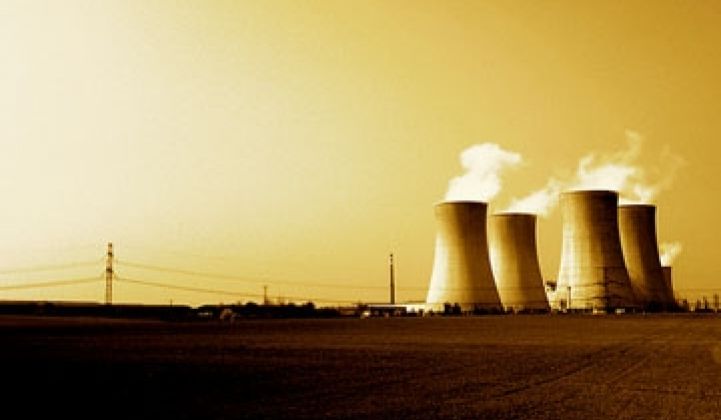For several years, the energy industry has been claiming that nuclear power is a green, cost-effective solution for global warming, and now it is asking the Nuclear Regulatory Commission to approve 26 new power plant proposals. Meanwhile, some in Congress are calling for the federal government to support the construction of 100 new reactors over the next two decades.
No doubt, expanding U.S. nuclear power beyond the current 104 reactors could help combat climate change. Nuclear plants -- which do not emit carbon dioxide during operation -- currently generate about 20 percent of U.S. electricity, and building more could reduce the 50 percent market share held by coal plants, the nation's primary source of global warming emissions.
But is nuclear power a solution we can afford? The short answer is no. Even discounting nuclear power's security and safety problems, the cost of construction could be the industry's Achilles' heel.
The nuclear industry likes to point out that it has low production costs, which it does. What it doesn't mention, however, are its rapidly escalating capital costs, those associated with paying the cost of plant construction, including financing. In the past, the industry has benefited from considerable federal and state government subsidies that mask the true cost of the technology, including staggering capital costs and the risk of catastrophic accidents, by shifting these burdens onto taxpayers and ratepayers. The industry is now seeking to shift even more costs and risks onto the public as part of pending climate and energy legislation.
In 2005, Congress authorized $60 billion in loan guarantees for new energy technologies. Of that amount, the Department of Energy (DOE) allocated $18.5 billion for new nuclear plants. But the industry wants more -- a lot more. The Nuclear Energy Institute, the industry's lobbying arm, says it needs a "permanent financing platform" to provide the industry a minimum of $100 billion in additional loan guarantees on top of the billions it already has been allocated.
In the 1960s and 1970s, the industry proposed to build some 200 plants, but as construction costs escalated, only about half were finished. Taxpayers and ratepayers were left footing the bill -- about $300 billion in today's dollars -- for abandoned plants, cost overruns for completed plants, and stranded investments that were higher than the wholesale market price for power. No energy company has ordered a new plant since 1978, and all plants ordered after 1973 were cancelled.
In 1985, Forbes magazine called the debacle "the largest managerial disaster in business history," and investors have stayed away ever since. In 2007, six top investment firms told the DOE in writing that they were unwilling to finance new reactors. Utility executives, meanwhile, will not finance new nuclear plants themselves. Both Wall Street and the industry would consider it, however, if taxpayers assumed the risk -- in the form of federal loan guarantees.
Taxpayers should be skeptical about such guarantees. First, projected construction costs have been spiraling out of control. In 2002, the nuclear industry estimated it would cost $2 billion to $3 billion to build a typical 1,100-megawatt reactor, which can supply power for about a million homes. Since then, the projected costs have jumped as high as $9 billion per unit.
Second, based on the industry's financial track record, the Government Accountability Office estimated that the average risk of default on a federal loan guarantee for nuclear plant construction is 50 percent. The Union of Concerned Scientists (UCS) used this rate of default and recent cost estimates to assess the overall risk to taxpayers for guaranteeing nuclear plant construction loans, concluding that taxpayers could be at risk for as much as $360 billion if 100 plants operating today were replaced with new plants by 2040. Without loan guarantees, no company has taken anything more than preliminary steps toward building a new plant.
An April 2009 UCS report, "Climate 2030: A National Blueprint for a Clean Economy," concluded that new reactors would be one of the most expensive options for producing "low-carbon" electricity, even ignoring the likelihood of cost overruns. The peer-reviewed study found that a combination of low-carbon energy polices would economically reduce carbon emissions from electricity generation 84 percent by 2030. New nuclear plants would not be an cost-effective part of the generation mix, however, at least not any more than the four new 1,100-megawatt reactors that were projected to be covered by existing subsidies and loan guarantees. Instead, the study found it would be more economical to meet a stringent emissions cap with a mix of energy efficiency, renewable resources, and combined-heat-and-power plants fueled by natural gas.
Fortunately, there are viable alternatives to nuclear power, including efficiency, wind, biomass and geothermal, which are not only more environmentally friendly and cheaper, but could be built much more quickly and at much lower risk to investors and taxpayers. And recent changes in the long-term outlook for U.S. natural gas supplies make nuclear power look even more uneconomical.
The potential price tag of yet another public bailout of the nuclear industry would dwarf the previous ones. Congress should think twice about putting hundreds of billions of taxpayer dollars at risk to underwrite a new generation of costly reactors that Wall Street and even the industry itself are unwilling to finance on their own. The power source that was once promised to be "too cheap to meter" may now be too costly to revive.
Elliott Negin is the media director for the Union of Concerned Scientists in Washington, D.C.



